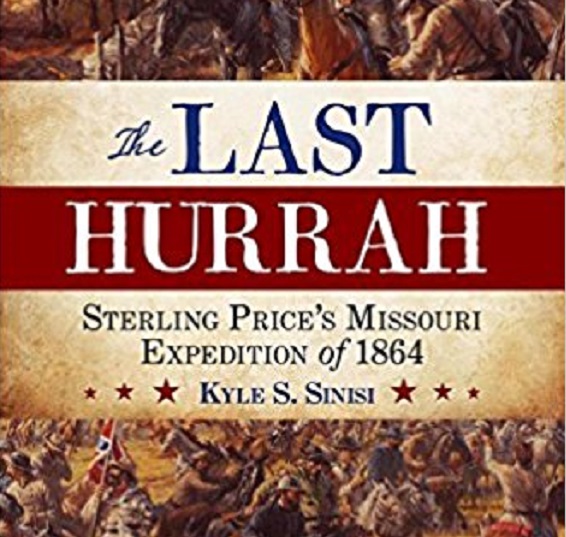A review of The Last Hurrah by Kyle S. Sinisi (Rowman & Littlefield, 2015).
General Sterling Price’s attempt to liberate Missouri from Union occupation in late 1864 was the last gasp of the Confederacy.
Price was a late convert to secessionism and President Jefferson Davis suspected his loyalty. There were also unsubstantiated rumors that unknown people intended to overthrow Davis and put Price into his place. Also, Price was the choice of secret societies in Missouri who would rally around Price, who would then become leader of a second Confederacy. After all, the Department of the Trans-Mississippi was huge, some 600,000 square miles, currently under command of Lt. Gen. E. Kirby Smith, with plenty of room for another nation.
A lot of this was spread by the Confederate governor of Missouri, Thomas C. Reynolds, who took over after the death of the Confederate governor. Reynolds thought little of Price’s military abilities and he thought Price’s ego might cause him to form a new nation instead of freeing Missouri. But he also felt that Price could not be sacked because he was so popular with Confederate sympathizers in Missouri. Although Reynolds thought a quick strike into Missouri was in order, Price was not the general he would choose. The best he could do was attach himself to Price and go along on the raid.
Finally, after Smith found he could not send troops in his Department to oppose Union General William T. Sherman in 1864, it was decided to generate a raid into Missouri with available troops. This army was called the Army of Missouri. The raid would be of short-term significance, capturing or destroying property. Recruits would be raised in central Missouri, while enemy troops would be diverted from other operations.
The raid would be by mounted troops only, in other words a large cavalry raid, although there were not enough horses or mules to mount everyone. There were not enough weapons to go around, either, and the wagons in the train were already breaking down. The officer corps distrusted each other. Smith did not trust Price. Price did not trust his two division commanders, Maj. Gen. James Fagan and Brig. Gen. John Marmaduke, but they were the only available senior commanders for the raid. His remaining division commander, Brig. Gen. Jo Shelby, was already with his troops in northern Arkansas.
So Price started out 350 miles from Missouri, with his 12,000 men, hundreds on foot with the trains, dismounted for lack of horses, and many having no weapons. The planning, such as it were, left Price with no supply line or depot system; what Price needed would have to be carried. It was hoped that the Confederate sympathizers in central Missouri would flock to Price, bringing weapons and horses. Then other necessities could be captured.
So what could possibly go wrong?
Kyle S. Sinisi, a professor at The Citadel in Charleston, S.C., tells us. This is a book whose subject has been only cursorily covered elsewhere and he digs in to find the truth.
If you are going to read this book, go to page 28 and dogear the page; this is a map of the invasion route and you will need it to keep up. There are maps of each battle, although the text mentions towns and areas not on these maps. Some of these maps are too small and should have been turned 90 degrees and enlarged in the book. The text thoroughly discusses the battles and the aftermath, from both Union and Confederate sides, but the paragraphs are very long, sometimes an entire book page long.
From this you will learn Price’s Missouri raid was not a last hurrah; it was a last gasp, with the death rattle quickly following.







